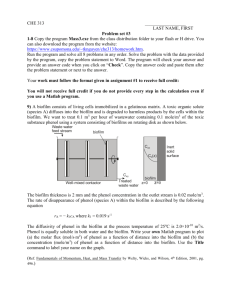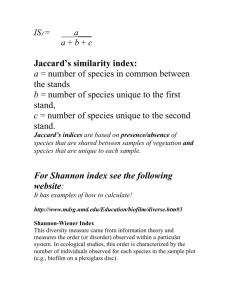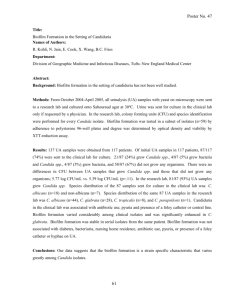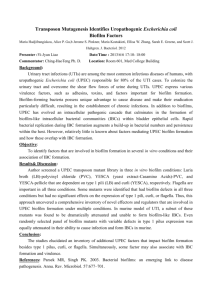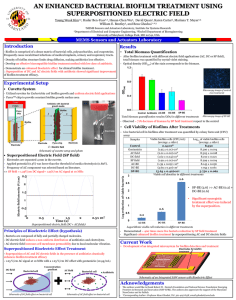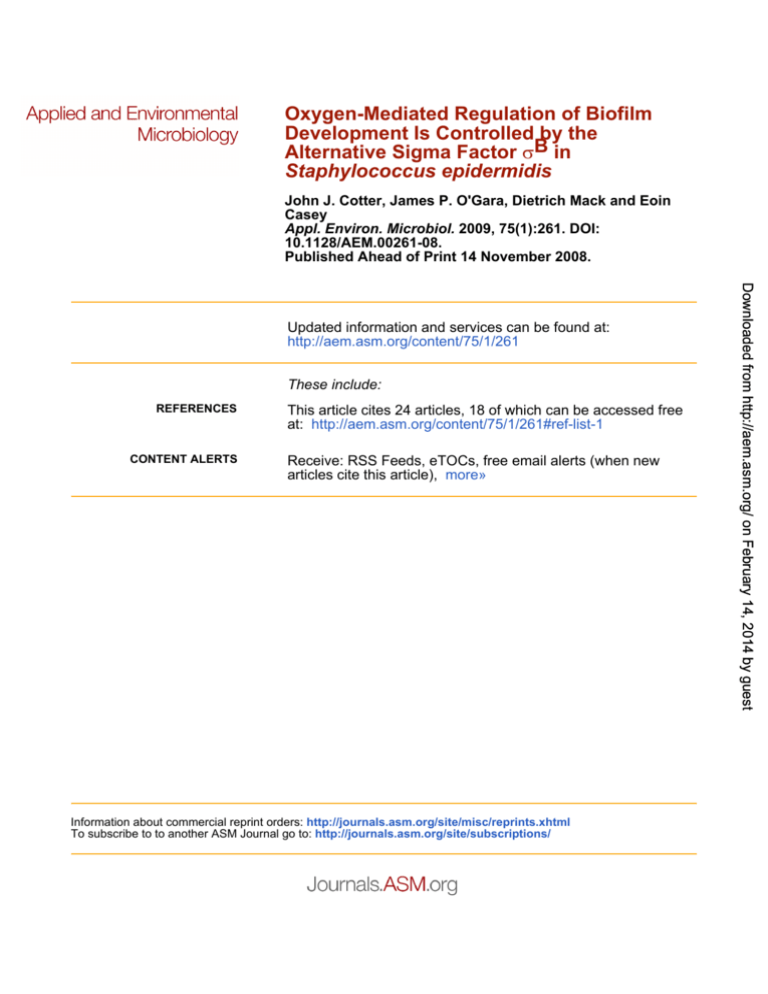
Oxygen-Mediated Regulation of Biofilm
Development Is Controlled by the
Alternative Sigma Factor σB in
Staphylococcus epidermidis
John J. Cotter, James P. O'Gara, Dietrich Mack and Eoin
Casey
Appl. Environ. Microbiol. 2009, 75(1):261. DOI:
10.1128/AEM.00261-08.
Published Ahead of Print 14 November 2008.
These include:
REFERENCES
CONTENT ALERTS
This article cites 24 articles, 18 of which can be accessed free
at: http://aem.asm.org/content/75/1/261#ref-list-1
Receive: RSS Feeds, eTOCs, free email alerts (when new
articles cite this article), more»
Information about commercial reprint orders: http://journals.asm.org/site/misc/reprints.xhtml
To subscribe to to another ASM Journal go to: http://journals.asm.org/site/subscriptions/
Downloaded from http://aem.asm.org/ on February 14, 2014 by guest
Updated information and services can be found at:
http://aem.asm.org/content/75/1/261
APPLIED AND ENVIRONMENTAL MICROBIOLOGY, Jan. 2009, p. 261–264
0099-2240/09/$08.00⫹0 doi:10.1128/AEM.00261-08
Copyright © 2009, American Society for Microbiology. All Rights Reserved.
Vol. 75, No. 1
Oxygen-Mediated Regulation of Biofilm Development Is Controlled by
the Alternative Sigma Factor B in Staphylococcus epidermidis䌤
John J. Cotter,1 James P. O’Gara,2 Dietrich Mack,3 and Eoin Casey1*
UCD School of Chemical and Bioprocess Engineering, Centre for Synthesis and Chemical Biology,1 and UCD School of
Biomedical and Biomolecular Science,2 University College Dublin, Belfield, Dublin 4, Ireland, and
Medical Microbiology and Infectious Diseases, Institute of Life Science, School of Medicine,
Swansea University, Swansea, Wales, United Kingdom3
Received 30 January 2008/Accepted 17 October 2008
Coagulase-negative staphylococci and Staphylococcus aureus
are the most common causes of device-related infections and
are known to cause 50 to 70% of intravenous-catheter-related
infections (1). Biofilm development by Staphylococcus epidermidis and S. aureus on the surfaces of implanted devices can
give rise to persistent and difficult-to-treat infections. In both S.
aureus and S. epidermidis, polysaccharide intercellular adhesin
(PIA) is an important component of the staphylococcal biofilm
(10). Synthesis of PIA requires enzymes encoded by the intercellular adhesion (ica) operon icaADBC (15, 17). A number of
studies have indicated that the ica locus may be a useful
marker for distinguishing between significant and contaminating isolates (6, 7, 14, 21). In S. epidermidis strains carrying the
ica locus, upregulation of ica operon expression and PIA production are also required for biofilm formation. Environmental
triggers such as ethanol and salt stress, excess glucose, and
subinhibitory antibiotic concentrations can also activate biofilm development (2, 3, 4, 11, 18, 19). A number of important
ica operon regulators have now been identified. The icaR gene,
which is located adjacent to the ica operon, encodes a transcriptional repressor of the ica locus (3, 11). Expression of icaR
is in turn repressed indirectly by the alternative stress-responsive sigma factor B (13). Thus, environmental conditions that
activate B result in repression of the icaR gene and deregulation of the icaADBC operon (2, 12, 16, 20).
Biofilm development by S. epidermidis 1457 (12) and its
isogenic mutant M15, which contains a Tn917 transposon insertion in the rsbU gene at the sigB locus (16), was investigated
under anaerobic conditions. Biofilm development on polycarbonate coupons was measured in a modified rotating-disk reactor (RDR; Biosurface Technologies Corp., MT), in which a
sparger extending from the lid to below the liquid level was
employed to enable precise control of dissolved oxygen concentrations. Profiles of oxygen utilization of S. epidermidis 1457
within the RDR were performed using oxygen sensor spots
(PreSens GmbH, Regensburg, Germany) for the extremes of
oxygen concentrations tested (Fig. 1). These profiles show that
the rate of oxygen utilization by the cells is higher than the
supply. It is important to note at this stage, however, that
though the profiles look identical from 7 h onwards (not
shown), the cells are in completely different conditions. Cells
sparged with 0% oxygen are forced to grow anaerobically,
whereas cells sparged at 21% consume oxygen at the rate
supplied.
Biofilm development in the reactor was examined at oxygen
concentrations of 0%, 7%, 14%, and 21% with a gas flow rate
of 0.5 liters min⫺1 in all cases. Each run initially involved a 24-h
batch phase, followed by a 24-h continuous phase in which
quarter-strength brain heart infusion (BHI) medium (Oxoid)
was fed at 90 ml h⫺1 using a peristaltic pump (Watson Marlow,
United Kingdom). Diluted concentrations of BHI medium are
commonly used by others to culture biofilms (2, 9, 25), and our
previous work (not shown) revealed quarter strength to be the
optimum nutrient concentration for biofilm growth by strain
1457 in our studies. Total RNA was extracted from biofilm
cells as described previously (2) with the following modifications. Immediately on termination of an RDR run, the rotating
disk was aseptically removed and washed. Biofilms were
scraped from the coupons and the Viton surface of the disk
and resuspended in RNAlater (Ambion, Austin, TX) to maintain the biofilm mRNA expression profile. Prior to RNA purification, RNAlater was removed and the biofilm was dispersed by treatment with 100 l 0.2 M sodium metaperiodate
(Sigma-Aldrich, Germany) for 5 min as described previously
(18). Reverse transcription-PCR (RT-PCR) analysis, using the
OneStep RT-PCR kit (Qiagen, United Kingdom), of ica
operon transcript levels in RNA extracted from biofilm cells
involved an RT step at 55°C for 30 min followed by 31 amplification cycles of 90°C for 20 s, 50°C for 20 s, and 72°C for 20 s.
Similar reaction conditions were used to measure ica operon
expression in RNA extracted from planktonic cells, but only 26
amplification cycles were required. RT-PCR analysis of transcript levels of asp23, which is a known target gene of B (8),
involved an RT step at 55°C for 30 min followed by 12 amplification cycles of 90°C for 20 s, 50°C for 20 s, and 72°C for 20 s.
16S rRNA yields were compared by agarose gel electrophore-
* Corresponding author. Mailing address: UCD School of Chemical
and Bioprocess Engineering, Engineering and Materials Science Centre, University College Dublin, Belfield, Dublin 4, Ireland. Phone: 353
1 7161877. Fax: 353 1 7161177. E-mail: eoin.casey@ucd.ie.
䌤
Published ahead of print on 14 November 2008.
261
Downloaded from http://aem.asm.org/ on February 14, 2014 by guest
Using a modified rotating-disk reactor to sparge oxygen to Staphylococcus epidermidis cultures, we found that
oxygen negatively regulates biofilm development by influencing the activity of B. Under anaerobic conditions,
increased B activity activates icaADBC, which encodes enzymes responsible for polysaccharide intercellular
adhesin synthesis, by repressing transcription of the negative regulator icaR.
262
COTTER ET AL.
sis, and the constitutively expressed gyrB gene (2) was used as
an internal standard in all RT-PCR experiments.
Oxygen availability in the infection environments of implanted medical devices, which typically involve biofilms, is
likely to vary, and environments may in some instances be
anoxic (22). Our data, obtained while tightly controlling oxygen
concentrations, revealed enhanced S. epidermidis biofilm formation under anaerobic conditions, with a statistical difference
evident between biofilms grown at 0% and 21% oxygen (P ⬍
0.05) (Fig. 2). Examination of planktonic cells grown at 0%
oxygen and 21% oxygen within the reactor (data not shown)
revealed that differences in biofilm CFU counts could be directly attributed to enhanced biofilm development. RT-PCR
analysis revealed a substantial increase in icaA expression under anaerobic conditions compared to that under aerobic (21%
FIG. 2. Biofilm development by S. epidermidis 1457 on polycarbonate coupons in a modified RDR after 48 h of growth in quarterstrength BHI medium at 21%, 14%, 7%, and 0% dissolved oxygen
concentrations. Error bars represent standard errors from three independent experiments.
FIG. 3. Comparative measurement of icaA, icaR, and gyrB (control) transcription by RT-PCR in biofilm biomass of S. epidermidis
1457 grown in a modified RDR in quarter-strength BHI medium at
21%, 14%, 7%, and 0% sparged oxygen concentrations. Comparative
intensities of 16S rRNA bands after agarose gel electrophoresis are
also shown. These experiments were performed three times, and representative results are shown.
oxygen) conditions (5) in both biofilm (Fig. 3) and planktonic
(Fig. 4) cells. It is important that ica transcripts are still detected at low levels in samples grown at 21% oxygen and that
the icaADBC transposon mutation abolishes biofilm formation
by 1457 cells (12). Concomitant with the activation of the ica
operon, expression of the icaR gene was also substantially
higher in cells grown at 21% oxygen, explaining, at least in
part, why more biofilm was consistently formed under anaer-
FIG. 4. Comparative measurement of icaA, icaR, asp23, and gyrB
(control) transcription by RT-PCR in 48-h planktonic cultures of an S.
epidermidis 1457 biofilm grown in a modified RDR in quarter-strength
BHI medium at 21% and 0% sparged oxygen concentrations. Comparative intensities of 16S rRNA bands after agarose gel electrophoresis are also shown. The cells were harvested from the reactor waste.
These experiments were performed three times, and representative
results are shown.
Downloaded from http://aem.asm.org/ on February 14, 2014 by guest
FIG. 1. Dissolved oxygen profiles for S. epidermidis 1457 planktonic
cultures grown in a modified RDR sparged with different oxygen
concentrations. Profiles are means of two independent runs.
APPL. ENVIRON. MICROBIOL.
VOL. 75, 2009
OXYGEN-MEDIATED BIOFILM REGULATION IN S. EPIDERMIDIS
263
activates ica transcription under anaerobic conditions and does
not modulate icaR expression (23). A potential role for SrrA in
S. epidermidis has yet to be investigated, but amino acid sequence alignments suggest that no SrrA homologue exists in S.
epidermidis. These findings may suggest that B is less important for oxygen-dependent biofilm regulation in S. aureus than
previously thought and are consistent with previous studies
indicating that B plays a more important role in biofilm regulation in S. epidermidis than in S. aureus (5, 12, 13, 24).
FIG. 5. Comparison of biofilm development of S. epidermidis 1457
and its isogenic rsbU mutant M15 on polycarbonate coupons in a
modified RDR after 48 h of continuous growth in quarter-strength
BHI medium or BHI medium supplemented with 10% ethanol. CFU
for biofilms grown under aerobic (21% oxygen) and anaerobic (0%
oxygen) conditions are shown. Error bars represent standard errors
from three independent experiments. EtOH, ethanol.
obic conditions. These data suggest that activation of the ica
locus under anaerobic conditions is the result of icaR repression. To investigate the possible mechanism of icaR repression
by oxygen, we examined the impact of oxygen on the activity of
the alternative sigma factor B by measuring transcription of
asp23. Significantly, asp23 expression was dramatically activated under anaerobic conditions, indicating that B activity is
increased in the absence of oxygen (Fig. 4). Under anaerobic
conditions in the modified RDR biomass, yields of the rsbU
mutant, S. epidermidis M15 (13), were significantly lower than
those of the wild-type strain (Fig. 5). These data strongly suggest that activation of B activity under anaerobic conditions
increases icaADBC expression, and accordingly biofilm formation, by repressing transcription of the icaR gene. Under aerobic conditions, biomass yields of M15 were similar to those of
the wild-type strain. These results, which contrast with previously published data (13), may be explained by differences in
the growth environment between the modified RDR and 96well plates. For example, localized anoxic regions are more
likely to occur in the latter, where the specific oxygen transfer
rate can be expected to be lower than in the RDR. Importantly, ethanol also activates the ica operon and biofilm development by repressing icaR transcription, but in a B-independent manner (2, 12, 13). Using the RDR system, we confirmed
that biofilm formation by M15 was restored to wild-type levels
under anaerobic conditions in BHI medium supplemented
with 4% ethanol (Fig. 5). These data support the existence of
two separate pathways for ica locus activation in S. epidermidis
and further reveal that anaerobic activation of ica operon expression and biofilm development is dependent on the B
regulatory pathway. It appears that B is less important for
biofilms under high-oxygen conditions (21% oxygen) than under low-oxygen conditions (0% oxygen) as the wild type (1457)
and the mutant exhibit similar biofilm phenotypes. In S. aureus,
the staphylococcal respiratory response regulator SrrA directly
REFERENCES
1. Archer, G. L. 1995. Staphylococcus epidermidis and other coagulase-negative
staphylococci, p. 1774–1784. In G. L. Mandell, J. E. Bennett, and R. Dolin
(ed.), Principles and practice of infectious diseases, 4th ed. Churchill Livingston, New York, NY.
2. Conlon, K. M., H. Humphreys, and J. P. O’Gara. 2002. icaR encodes a
transcriptional repressor involved in environmental regulation of ica operon
expression and biofilm formation in Staphylococcus epidermidis. J. Bacteriol.
184:4400–4408.
3. Conlon, K. M., H. Humphreys, and J. P. O’Gara. 2002. Regulation of icaR
gene expression in Staphylococcus epidermidis. FEMS Microbiol. Lett. 216:
171–177.
4. Conlon, K. M., H. Humphreys, and J. P. O’Gara. 2004. Inactivations of rsbU
and sarA by IS256 represent novel mechanisms of biofilm phenotypic variation in Staphylococcus epidermidis. J. Bacteriol. 186:6208–6219.
5. Cramton, S. E., M. Ulrich, F. Götz, and G. Döring. 2001. Anaerobic conditions induce expression of polysaccharide intercellular adhesin in Staphylococcus aureus and Staphylococcus epidermidis. Infect. Immun. 69:4079–4085.
6. Fitzpatrick, F., H. Humphreys, E. Smyth, C. A. Kennedy, and J. P. O’Gara.
2002. Environmental regulation of biofilm formation in intensive care unit
isolates of Staphylococcus epidermidis. J. Hosp. Infect. 52:212–218.
7. Frebourg, N. B., S. Lefebvre, S. Baert, and J. F. Lemeland. 2000. PCR-based
assay for discrimination between invasive and contaminating Staphylococcus
epidermidis strains. J. Clin. Microbiol. 38:877–880.
8. Gertz, S., S. Engelmann, R. Schmid, K. Ohlsen, J. Hacker, and M. Hecker.
1999. Regulation of B-dependent transcription of sigB and asp23 in two
different Staphylococcus aureus strains. Mol. Gen. Genet. 261:558–566.
9. Goeres, D. M., L. R. Loetterle, M. A. Hamilton, R. Murga, D. W. Kirby, and
R. M. Donlon. 2005. Statistical assessment of a laboratory method for growing biofilms. Microbiology 151:757–762.
10. Heilmann, C., O. Schweitzer, C. Gerke, N. Vanittanakom, D. Mack, and F.
Gotz. 1996. Molecular basis of intercellular adhesion in the biofilm-forming
Staphylococcus epidermidis. Mol. Microbiol. 20:1083–1091.
11. Jefferson, K. K., D. B. Pier, D. A. Goldmann, and G. B. Pier. 2004. The
teicoplanin-associated locus regulator (TcaR) and the intercellular adhesin
locus regulator (IcaR) are transcriptional inhibitors of the ica locus in Staphylococcus aureus. J. Bacteriol. 186:2449–2456.
12. Knobloch, J. K.-M., K. Bartscht, A. Sabottke, H. Rohde, H. H. Feucht, and
D. Mack. 2001. Biofilm formation by Staphylococcus epidermidis depends on
functional RsbU, an activator of the sigB operon: differential activation
mechanisms due to ethanol and salt stress. J. Bacteriol. 183:2624–2633.
13. Knobloch, J. K.-M., S. Jager, M. A. Horstkotte, H. Rohde, and D. Mack.
2004. RsbU-dependent regulation of Staphylococcus epidermidis biofilm formation is mediated via the alternative sigma factor B by repression of the
negative regulator gene icaR. Infect. Immun. 72:3838–3848.
14. Li, H., L. Xu, J. Wang, Y. Wen, C. Vuong, M. Otto, and Q. Gao. 2005.
Conversion of Staphylococcus epidermidis strains from commensal to invasive
by expression of the ica locus encoding production of biofilm exopolysaccharide. Infect. Immun. 73:3188–3191.
15. Mack, D., W. Fischer, A. Krokotsch, K. Leopold, R. Hartmann, H. Egge, and
R. Laufs. 1996. The intercellular adhesin involved in biofilm accumulation of
Staphylococcus epidermidis is a linear -1,6-linked glucosaminoglycan: purification and structural analysis. J. Bacteriol. 178:175–183.
16. Mack, D., H. Rohde, S. Dobinsky, J. Riedewald, M. Nedelmann, J. K.-M.
Knobloch, H.-A. Elsner, and H. H. Feucht. 2000. Identification of three
essential regulatory gene loci governing expression of the Staphylococcus
epidermidis polysaccharide intercellular adhesin and biofilm formation. Infect. Immun. 68:3799–3807.
17. Maira-Litran, T., A. Kropec, C. Abeygunawardana, J. Joyce, G. Mark III,
D. A. Goldmann, and G. B. Pier. 2002. Immunochemical properties of the
Downloaded from http://aem.asm.org/ on February 14, 2014 by guest
This research was funded by Science Foundation Ireland grant 04/
BRG/E0072.
We thank Liam Morris, Tom Burke, Frank Mac Loughlin, Eoin
Syron, and Barry Heffernan for engineering expertise and Linda Holland, Sinéad O’Donnell, and Kate Malone for RNA advice and assistance.
264
18.
19.
20.
21.
COTTER ET AL.
staphylococcal poly-N-acetylglucosamine surface polysaccharide. Infect. Immun. 70:4433–4440.
O’Neill, E., C. Pozzi, P. Houston, D. Smyth, H. Humphreys, D. A. Robinson,
and J. P. O’Gara. 2007. Association between methicillin susceptibility and
biofilm regulation in Staphylococcus aureus isolates from device-related infections. J. Clin. Microbiol. 45:1379–1388.
Rachid, S., K. Ohlsen, U. Wallner, J. Hacker, M. Hecker, and W. Ziebuhr.
2000. Alternative transcription factor B is involved in regulation of biofilm
expression in a Staphylococcus aureus mucosal isolate. J. Bacteriol. 182:6824–
6826.
Rachid, S., K. Ohlsen, W. Witte, J. Hacker, and W. Ziebuhr. 2000. Effect
of subinhibitory antibiotic concentrations on polysaccharide intercellular
adhesin expression in biofilm-forming Staphylococcus epidermidis. Antimicrob. Agents Chemother. 44:3357–3363.
Rohde, H., M. Kalitzky, N. Kroger, S. Scherpe, M. A. Horstkotte, J. K.-M.
Knobloch, A. R. Zander, and D. Mack. 2004. Detection of virulence-associated genes not useful for discriminating between invasive and commensal
APPL. ENVIRON. MICROBIOL.
22.
23.
24.
25.
Staphylococcus epidermidis strains from a bone marrow transplant unit.
J. Clin. Microbiol. 42:5614–5619.
Rowlinson, M. C., P. LeBourgeois, K. Ward, Y. Song, S. M. Finegold, and
D. A. Bruckner. 2006. Isolation of a strictly anaerobic strain of Staphylococcus epidermidis. J. Clin. Microbiol. 44:857–860.
Ulrich, M., M. Bastian, S. E. Cramton, K. Ziegler, A. A. Pragman, A.
Bragonzi, G. Memmi, C. Wolz, P. M. Schlievert, A. Cheung, and G. Doring.
2007. The staphylococcal respiratory response regulator SrrAB induces ica
gene transcription and polysaccharide intercellular adhesin expression, protecting Staphylococcus aureus from neutrophil killing under anaerobic
growth conditions. Mol. Microbiol. 65:1276–1287.
Valle, J., A. Toledo-Arana, C. Berasain, J.-M. Ghigo, B. Amorena, J. R.
Penadés, and I. Lasa. 2003. SarA and not B is essential for biofilm development by Staphylococcus aureus. Mol. Microbiol. 48:1075–1087.
Werner, E., F. Roe, A. Bugnicourt, M. J. Franklin, A. Heydorn, S. Molin, B.
Pitts, and P. S. Stewart. 2004. Stratified growth in Pseudomonas aeruginosa
biofilms. Appl. Environ. Microbiol. 70:6188–6196.
Downloaded from http://aem.asm.org/ on February 14, 2014 by guest


